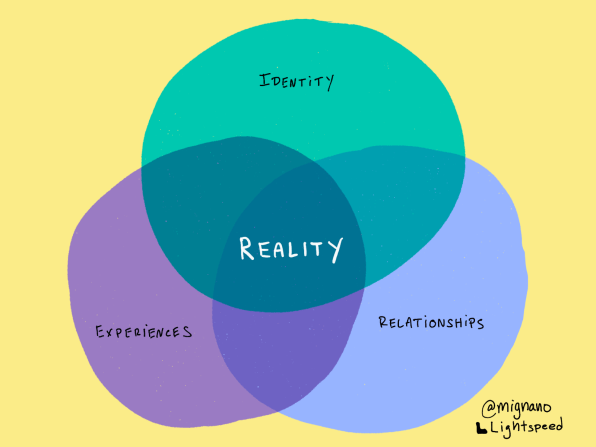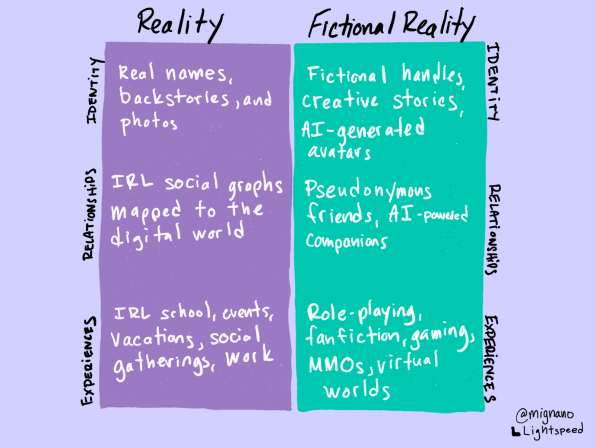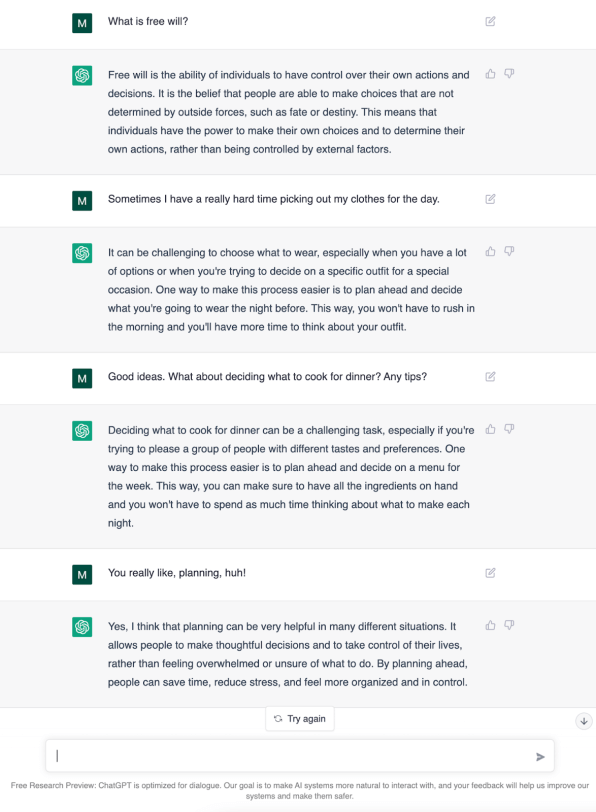Fictional reality: Why the real metaverse doesn’t require a headset
By Michael Mignano
Much has been said of, written about, and invested in the “metaverse.” For the uninitiated, the metaverse is a conceptual version of the future in which we’re all interacting—for work, play, and everything in between—in an alternate version of reality that’s powered by VR, AR, BCI (brain computer interfaces), or a combination of all of the above. This promised future requires step changes to the behavior of how we all interact with both hardware and software on the internet. As a result, countless companies have invested many billions of dollars in this future, none more so than Meta (fka Facebook), which went as far as rebranding themselves to signal their dedication to the cause.
But what if the internet, mixed with recent breakthroughs in artificial intelligence, is already enabling us to live in an alternate version of reality? Up until this point, we’ve been living our lives online in digital replicas of the real world, all with varying degrees of fidelity. Some are low fidelity, and mostly made up of text, photos, and asynchronous videos (e.g. social media platforms, email, messaging, etc), while others are much higher fidelity and more immersive, enabling us to get lost in experiences that more deeply connect with our senses (e.g. gaming, today’s VR/AR applications, etc.). However, what all of these experiences have lacked thus far is a layer of high-quality intelligence that’s been good enough to convince us that the people and experiences we’re interacting with on the other side of the screen are actually real. All of this is now changing.
AI is making it possible for us to live out alternative versions of reality on the platforms where we’re already spending our time; not on futuristic devices and products that may not arrive for another decade. This is fictional reality, and it’s where much of our online behavior is headed.
But to understand what fictional reality is, we must first define reality itself.
What is “reality?“
Merriam-Webster’s dictionary defines reality as the quality or state of being real. I’d like to take that definition a step further and qualify it. I believe that reality is the overlap of three core elements of our lives:

We were all born with given names and appearances. Over time, we cultivate a cluster of personal and professional relationships. We collect unique experiences as we go about our lives, all of which shape who we are as people. For most of us, the vast majority of this reality has taken place offline, in the real world (aka IRL).
However, increasingly, each of us is spending more and more of our realities online, in the digital world. This has meant mapping the three elements of reality—our identities, relationships, and experiences—to the digital world. For example:
But when our real identities, relationships, and experiences start becoming fictionalized online, reality becomes fictional reality.
Enter Fictional Reality
Fictional reality is the concept of people living, playing, or working online through fictionalized versions of their identity, relationships, and experiences. While this is not a brand-new behavior, fictional reality is becoming more positive, commonplace, and accepted.
This new wave of fictional reality is different from internet anonymity, or even pseudo-anonymity. People have been pursuing versions of their lives with varying degrees of anonymity since the beginning of the internet. Oftentimes (though not always), the intent behind online anonymity has been for negative, cynical, or nefarious reasons, such as to hide the true intent or impression of one’s actions. “Finstagram” accounts, pseudonymous accounts on Twitter, and burner Reddit profiles are just a few of the many ways people have chosen to conceal their true identities and intentions on the internet.
But fictional reality is something much different; with fictional reality, people are crafting new versions of themselves online for positive reasons, such as to express creativity, gain confidence, or to share a part of their identity or interests that they aren’t able to showcase to the offline world. This may be because the fictionalized version of themselves isn’t socially accepted IRL, or it’s simply not technically possible. Fictional reality can even enable people to seek companionship not found offline or to express an opinion shunned by one’s IRL community.

And just like how reality is the overlap between identity, relationships, and experiences, the same is true in fictional reality.
Your fictional identity
Fictional reality starts with identity. Increasingly, more and more people are representing themselves through fictionalized names, backstories, and even avatars.
To some extent, this behavior goes back as far as Aol AIM screen names; but look no further than Discord to witness the many new ways people are fictionalizing their identity through creative names/handles and backstories, signaling to the world that they are something other than their IRL counterparts. And this behavior is now extending to other platforms through visual identities and avatars, too.
As of this writing, it seems like half of the people I follow on Twitter have an avatar showing a graphical, highly exaggerated representation of themselves. Most of these are powered by an app called Lensa, which leverages generative AI, powered by Stable Diffusion (a text-to-image model created by Stability.ai, a Lightspeed portfolio company), to create these avatars based on 10 to 20 selfies you upload to the app. The app is immensely popular; it’s gone from relative obscurity to being the #1 overall app in the U.S. App Store in a matter of days.
The explosion of Lensa’s popularity—and therefore mainstream interest in artificial intelligence—is by itself interesting; what may be far more interesting is the sheer number of people who are excited to visually represent themselves as someone they are not IRL.
Not only are few challenging the usage of these fictional avatars, but instead, most are embracing it, rushing to the App Store to acquire their own. It seems like only a few short years ago, many of us were careful to not overly “Facetune” our selfies to reveal that they had been manipulated to conceal undesirable aspects of our true appearance. Yet, all of a sudden, the opposite seems to be true: millions are excited to showcase the most exaggerated versions of ourselves online.

We may look back on this moment as the turning point in which many people on the internet became comfortable portraying themselves as fictionalized characters.
Your fictional relationships
But fictional reality is about more than just your identity; it’s also about the people—real or not—you choose to interact with.
If you imagine a world in which more and more of us are assuming fictional identities, then it’s only natural to assume that those we are interacting with online will be doing the same. Our friend graphs and inboxes, once dominated by real names and photos, may slowly shift to include more and more fictional characters. And in many cases, human beings won’t be controlling the identities; it’ll be artificial intelligence.
Look no further than ChatGPT, a conversational language model recently released by OpenAI that’s taken the internet by storm over the past week. If ChatGPT screenshots littering Twitter time lines and news articles are any indication, humanity has invested countless hours speaking to artificial intelligence—as if it were a human being—over the past week. In fact, on December 5, only days after it had been launched, Sam Altman (OpenAI’s CEO) noted that 1 million people had already interacted with ChatGPT.

But why limit our communication with artificial intelligence to a single text box? That’s where Circle Labs comes in.
Circle Labs (disclosure: a Lightspeed portfolio company) is proof that people are becoming increasingly willing (and excited!) to talk to fictional friends where they normally talk to real friends. Through the company’s creator platform—which enables anyone to generate their own AI-powered friends (aka shapes) and then deploy them to platforms like Discord and Twitter—people have exchanged millions of messages with Circle Lab’s artificial intelligence.
And the ways in which people are interacting with these friends are fascinating; many are now deploying and including shapes as part of their IRL friend groups in their favorite online communities. For example, whereas it may have previously been five human friends chatting all day on Discord, now it’s those same five friends plus a few shapes to add a new dimension of companionship, creativity, entertainment, and conversation.

Your fictional experiences
If fictional reality does end up looking like the version of metaverse that’s been so heavily portrayed in demo videos, essays, news articles, and Meta (the company) presentations, it’ll be through experiences. Virtual events, concerts, online meetings, and social gatherings will serve as the experience layer that brings us together and shapes our fictional realities. The closer the experiences get to our senses (such as through VR headsets), the more lifelike these fictional realities will become. But the most obvious application of fictional experiences is already one of the most popular forms of media today: gaming.
So many of us already spend countless hours daily as fictionalized characters in games like Fortnite or on platforms like Roblox. This is not a new phenomenon. More than a decade ago, games like World of Warcraft (and EverQuest before that) served as havens for millions to escape their realities and get intentionally lost among clans of new online friends. They’d go on quests, overcome group challenges, and level up their characters in beautiful, vast, and fictional worlds.
But lower fidelity—and lower friction—ways of sharing experiences among fictional identities are emerging. Mascot, a new social platform, enables anyone to create collaborative stories and fan fiction for their characters. Once users create and fully customize their characters (across a variety of attributes, including gender, pronouns, likes, dislikes, special powers, and backstories), they’re matched with other human-powered (yet fictional) characters with which they can create new stories to share with the world.
Many of the above games have their roots in paper-and-die games like Dungeons and Dragons and immersive fantasy novels that have been written for centuries. Imagining yourself navigating an alternate universe as an alternate version of yourself is clearly a fundamental impulse of human creativity. But now, AI is making it possible to go beyond imagining.
This is just the beginning. As more of us take on fictional identities and build networks of fictional relationships, more and more experiences will be purpose-built for this new version of reality.
What’s next?
Given the speed at which artificial intelligence is reshaping how we all interact online, it’s impossible to know what comes next. What’s clear, however, is that we need not wait for better, cheaper, faster—or more comfortable!—hardware (read: headsets) to give us permission to live in fictional realities. The digital platforms on which we already spend most of our time, money, and attention—plus AI—are already doing that for us.
Today’s fictional realities are well on their way to enabling many of us to live out more creative, expressive, and for some—human—versions of our lives. And for some, fiction may end up being far more interesting than reality. After all, if you spend more time on the internet than you do IRL, who’s to say which version of your identity is real and which is fictionalized?
What do you think? Are fictional realities already here? Or are we experiencing a temporary window of escapism along our path to a true, hardware-enabled metaverse? I’d love to hear your feedback on Twitter or Linkedin.
Thanks to Paul Smalera, Meredith Kendall Maines, Moritz Baier-Lentz, and Faraz Fatemi for feedback and editing. Special thanks to Anushk Mittal, Noorie Dhingra, Artificial Intelligence, and tweets by Nikita Bier and Suhail Doshi for extra inspiration.
Michael Mignano is a partner at Lightspeed, a global venture capital firm, and the cofounder of Anchor, the world’s largest podcasting platform. Follow him on Twitter or sign up to get his essays on technology, strategy, product, and media directly in your inbox.
(16)



